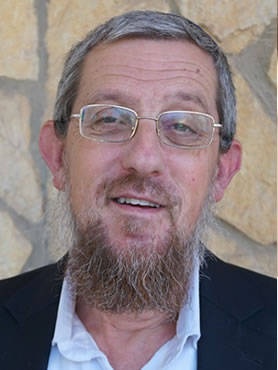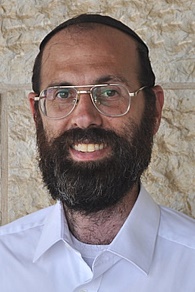With this Aharon will Enter the Sanctuary
הרב אריה שטרן
When the kohen gadol enters the inner Sanctuary once a year, he is commanded to take from the blood of the bull and the blood of the goat and to sprinkle eight times, once high and seven times downwards.
This alludes to what Chazal comment in the Mechilta on Parshat Shelach, in regards to the Song of the Sea:
"Then (az) Moshe sang." (Shemot 15:1) A – one; Z – seven; this is eight. Moshe said: In the merit of circumcision, which was given for the eighth [day], the sea was split; let us praise with az.
R. Levi said: "To Him who divided (l'gozer) the Red Sea into parts (l'gezarim)." (Tehillim 136:13) In Aramaic circumcision is called "gezorin" – in the merit of circumcision the sea was divided.
The kohen gadol's entrance to the inner Sanctuary is also connected to the merit of circumcision. Chazal state in Vayikra Rabbah (21:6):
"With this (b'zot) Aharon will enter the Sanctuary." R. Yudan interpreted the verse about the kohen gadol when he entered the inner Sanctuary. Many bundles of mitzvot were in his hand, in the merit of Torah – "this is the Torah;" in the merit of circumcision – "this is my covenant," etc.
The understanding of this passage is rooted in the Maharal's well-known principle regarding the numbers seven and eight. The material world was created in seven days of creation; hence, the number seven represents the natural world. When a person rises to the supernatural realm, he enters a world represented by the number eight.
When a person is born, his natural state is to be born uncircumcised. Torah and mitzvot are intended to raise a person above nature. Therefore, the Torah commanded that on the eighth day a person's flesh should be circumcised. Through this, the sign of the holy covenant is forever stamped in his body. As a member of Am Yisrael, he is not ruled by the natural world, but rather he is connected to an upper realm which is above nature. The verse, "mi ya'aleh lanu hashamayma – who will go up for us towards heaven" (Devarim 30:12) – is the acronym of milah. Through circumcision, which is done on the eighth day, we rise heavenwards.
The entire Torah was given to us in the manner of the number eight. When Bnei Yisrael left Egypt, they were commanded to count seven weeks, and at the beginning of the eighth week they were privileged to receive the Torah. So, too, ch. 19 of Tehillim begins: "The heavens declare the glory of G-d." The creation of the world is described in seven verses, and in the eighth verse begins the description of the Torah – "The Torah of Hashem is perfect."
In the inner Sanctuary was the Ark, and, in it, were the Tablets. This was the place that was entirely holy, on a level that is above nature. Whereas the Sanctuary symbolizes natural holiness, and in it were the Shulchan and the Menorah of seven branches, the inner Sanctuary symbolizes the world that is above nature, above all the limitations of nature. The Ark does not take up any space, and stood in a miraculous manner. (Megillah 10b)
On Yom Kippur, Am Yisrael rise towards heaven. They are without food and without drink, without other physical occupations, exactly as Chazal describe the world to come. Through the elevation of Klal Yisrael, their prime representative – the kohen gadol, especially elevates. This elevation allows him to enter all the way in. In the merit of Torah and in the merit of circumcision the kohen enters the supreme holy place, and there he sprinkles one high and seven downwards, as the numerical value of az. This sprinkling connects Klal Yisrael to the upper realm with a enduring bond.
On Rosh Hashana the world renews yearly. This renewal is the renewal of the natural world, together with all its natural laws. However, Yisrael do not suffice with this, and after ten days of spiritual self-preparation, they connect with the highest realm.
The Sefat Emet, in his sermons for Rosh Hashana, explains what we ask, "that we should be for a head and not for a tail." We should ask, "that we should be a head and not a tail." Rather, our true request is that we should belong to the Providence of the "head," and not the direction of the "tail." What are those two manners of guidance? The rule of nature is the rule of the tail, and the rule that is above nature is the rule of the head.
An influence (shefa) of purity descends on us from Heaven on Yom Kippur. "Fortunate are you Israel ... who purifies you? Your Father in heaven." Through our detachment from the natural, material, world, we connect to the upper, pure world, and from there we will merit pardon, forgiveness and atonement.
קוד השיעור: 3912
לשליחת שאלה או הארה בנוגע לשיעור:


.jpg)



.jpg)